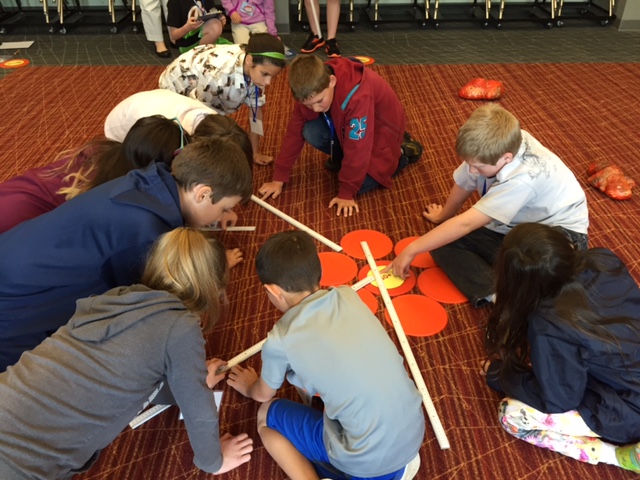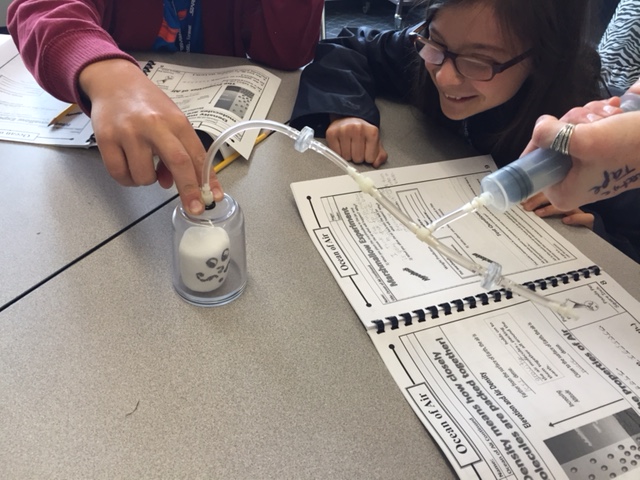Target 3. Flexible Learning Environments – FWSU will maximize flexible learning environments by redefining the school day, promoting learning experiences that extend beyond the school classroom, and fostering creativity, innovation and differentiated learning opportunities for all.Action Step – (1) Provide students with access to content, resources and methods for learning beyond the school day and beyond the school walls. (2) Develop opportunities for students to collaborate, innovate, create and conceptualize in all learning settings. (3) Make relevant and authentic problems become the focus of connected learning.Indicators of Success – (1) The school calendar and definition of school day changes to become flexible and responsive to the needs of students. (2) Students are engaged in answering authentic questions and solving problems in collaborative settings.
Fifth and sixth graders in Fletcher are flying high these days as they work to complete an intensive 25-hour StarBase Vermont STEM curriculum.
STEM, an acronym for science, technology, engineering and mathematics, was coined in the early 2000s by the National Science Foundation. Since that time, educators have increasingly recognized the importance of integrating these subjects and applying them to real-life problems as part of student learning.
The StarBase program, located on the Vermont Air National Guard base in South Burlington, is an affiliate of the U.S. Department of Defense StarBase educational initiative. (Read more about the national program here.) It’s curriculum focuses on physics, chemistry, technology, engineering, math operations and application and STEM careers. Students spend part of the 25 hours at the program’s location and instructors also teach lessons at the school.
“The experiences that students participate in at StarBase continue the learning that we have given them here in STEM,” fifth and sixth grade teacher Tracey Godin said. “The teachers at StarBase really relate the learning back to actual real-world problems and professions.”
The StarBase Mission includes fostering collaboration and healthy choices, exposing children to cutting-edge technology and promoting community, all through hands-on STEM instruction that meets or exceeds national standards. The program opened its doors in 1994 and reaches more than 1,300 Vermont students annually. There is no fee for schools to participate.
“The program consists of really fun, hands-on activities,” Godin said. “Our students see STEM in action and they see and understand the application and meaning of the concepts… It’s everything you want a classroom to be. Everyone’s ideas are honored and everybody is engaged.”
During the program’s physics component, students learn Newton’s Laws of Motion through hands-on experiments that include model rocketry. The construction of rockets culminates in a school-based launch. Fletcher’s launch is scheduled forFriday, June 12th, at 8:30, weather permitting. The community is invited to attend. Other physics topics include fluid mechanics and aerodynamics, much of which is learned through experiments and observations of military planes that enter and exit the base on which StarBase is housed.
“I learned a lot going there for just a few days,” sixth grader Delaney Sweet-Werneke said. “We learned what molecules look like and what things go together to make them. It’s nice to get out of the regular classroom and have a different place to learn because they have a lot of stuff like dimensional printers and robots.”
Building blocks of matter, physical and chemical changes and atmospheric properties are all taught as part of the program’s chemistry strand. Additionally, technology innovations including the latest in mapping, nanotechnology, robotics and chromatography (a method for separating organic and inorganic compounds to determine their composition) are featured at StarBase.
“If you want to become a scientist or engineer, you need to know a bunch of stuff about science and molecules, properties of matter and the Periodic Table of Elements,” sixth grader Emily Ashton said. “Now I know about gasses and liquids and solids. If I were to become a scientist I would need to know all about this.” Ashton, who aspires to become a police detective or FBI agent, finds the science particularly interesting.
Three-dimensional computer-aided design (CAD), along with the engineering and design process, comprise the engineering elements of the program, while number relationships, measurement, geometry and data analysis bring in the mathematics.
“The experience showed me how many careers there are for STEM and opened my eyes to how many things you can go to college for that involve engineering,” sixth grader Jarrett Sweet said. Sweet, who lives on a technology-driven family farm that incorporates robots, found programming the robots at StarBase most interesting.
“Subjects that are STEM-related are often forgotten or not always as exciting as we present them,” said Paige Montgomery, Unit Chief and Site Coordinator of StarBase in Burlington. “We do hand-on, mission-based activities and problem-solving. Connecting with elementary school students is a great age because they are starting to think about their future and what they are interested in. Making those hands-on connections is a really important thing to help them understand that STEM can be fun and relate to careers and their future.”
Working with Fletcher has been a really positive and energetic experience. The students were really engaged and excited. The school was a very friendly place and the atmosphere was welcoming and exciting. We look forward to working with Fletcher next year. It was a great way to end our school year.”
Read more about the evolution of STEM here.






